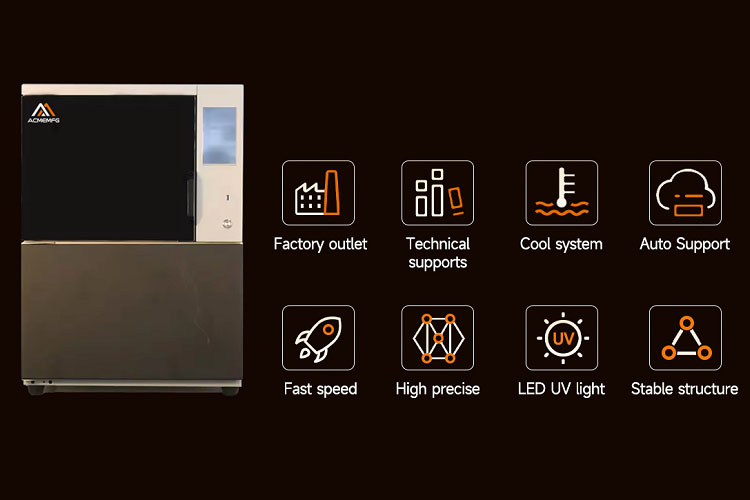Sinking and pull-up DLP 3D printers have significantly different characteristics in many aspects. These characteristics are mainly reflected in printing principles, stability, efficiency, cost-effectiveness and application fields.
1. Printing principle
Sinking DLP 3D printer: Using digital light processing technology (DLP), during the printing process, the molding platform (or printing tray) gradually sinks into the liquid resin. The light source illuminates from above and solidifies the resin layer by layer to form a three-dimensional model. Because the platform sinks, the model is naturally supported by the liquid resin during the curing process, reducing the need for additional support structures.
Pull-up DLP 3D printer: It also uses DLP technology, but the printing platform moves upward. During the printing process, the platform rises layer by layer, and the cured resin layer is peeled off and left on the platform to form a three-dimensional model. Due to the need to peel off the cured resin layer, pull-up printers may face greater release force and stability challenges during the printing process.
2. Stability
Sinking DLP 3D printer: Since the model is naturally supported by the liquid resin during the curing process and is not affected by release force, the printing process is more stable and reduces the risk of printing failure due to model deformation or falling off.
Pull-up DLP 3D printer: When peeling off the cured resin layer, it is necessary to overcome the influence of the release force and the gravity of the model, which may cause the model to deform, fall off, or be damaged, thus affecting printing stability.
3. Printing efficiency
Submersible DLP 3D Printers: Due to the reduced need for support structures and improved printing stability, submersible printers are often able to complete print jobs faster and reduce material waste and post-processing costs. In addition, since there is no need to frequently replace consumables such as release films, its long-term operating costs are relatively low.
Pull-up DLP 3D printer: Due to the need for additional support structures and issues such as dealing with release forces, pull-up printers may have lower printing efficiency and higher material waste and post-processing costs. At the same time, frequent replacement of consumables such as release films will also increase its long-term operating costs.
4. Cost-effectiveness
Sinking DLP 3D printer: Due to its high precision, high stability and cost-effectiveness, the sinking DLP 3D printer has broad application prospects in multiple fields. Especially in the fields of jewelry, medical, scientific research, rapid prototyping and small batch production, sinking printers can significantly reduce production costs and improve production efficiency.
Top-pull DLP 3D printers: Although they may be inferior to sink-type printers in some aspects, top-pull printers may be a more economical option when budget is limited or small-scale production is required. However, in terms of long-term operating costs and efficiency, submersible printers are often more advantageous.
5. Application areas
Sinking DLP 3D printer: widely used in jewelry, medical, scientific research and other fields as well as rapid prototyping and small batch production. These fields have high requirements on model accuracy, stability and cost, and the sinking printer just meets these needs.
Pull-up DLP 3D printer: Although it may be limited in some areas, pull-up printers still have certain application value. Especially in some specific application scenarios or when budget is limited, pull-up printers may be a viable option.
In summary, there are significant differences between sinking and pull-up DLP 3D printers in terms of printing principles, stability, efficiency, cost-effectiveness, and application fields. When choosing the right printer, you need to consider factors such as specific application needs, budget, and performance requirements.

